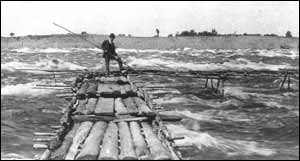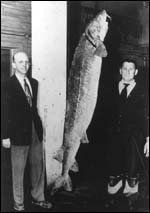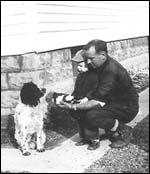

| Picture Caption: A man is sturgeon fishing from an extended walking platform over the Long Sault Rapids, ca. 1890 (Courtesy of the St. Lawrence County Historical Association Collection) |
 Forget about "Big Muddy" or the "Mighty Mississippi." These great rivers pale by comparison in the minds of the people who live along the shorelines of the St. Lawrence River, in southern Ontario and Quebec and northern New York. The passion for "The River" is palpable among natives and summer residents alike. Because of those feelings, a significant oral tradition-of personal reminiscences, tall tales, and local legends-has developed over the generations, and that is why we at TAUNY created 'The River' Project.
Forget about "Big Muddy" or the "Mighty Mississippi." These great rivers pale by comparison in the minds of the people who live along the shorelines of the St. Lawrence River, in southern Ontario and Quebec and northern New York. The passion for "The River" is palpable among natives and summer residents alike. Because of those feelings, a significant oral tradition-of personal reminiscences, tall tales, and local legends-has developed over the generations, and that is why we at TAUNY created 'The River' Project.
| Picture Caption: Fred Shurtleff and George Duprey of Ogdensburg with a 200 plus pound sturgeon at the old boathouse, Ogdensburg, 1929. (Courtesy of Gena Duprey) |

While the St. Lawrence River extends about 775 miles from its western source in the Great Lakes to its mouth in the Gulf of St. Lawrence, only slightly more than a 100 mile stretch of it shares the border between Canada and the United States. In that short distance, however, what a history there is! From the earliest hunting encampments of the Iroquois and Algonquins to the creation of the St. Lawrence Seaway, the river has been home to rugged, resourceful, independent-minded people who have learned to live with the challenges of its swift currents and harsh climate. It has also been a compelling destination for summer residents, visiting sportsmen and women, and tourists, pursuing its bountiful wildlife and great beauty.
Along the St. Lawrence in New York's North Country, there is surprising diversity, from Tibbet's Point at Cape Vincent to the Mohawk nation at Akwesasne. Within that short distance there are some amazing things: the 1000 Islands [closer, they say now, to 1800, but who's counting?], two locks and the main shipping channel for the St. Lawrence Seaway, [one of the engineering marvels of the modern world], the Robert Moses Power Dam [ten football fields long, generating hundreds of thousands of kilowatts daily], the Mohawk nation ["land where the partridge drums," which actually is set in both Canada and the United States, Ontario, Quebec and New York], and three international bridges [where a border crossing is, according to locals, "a minor inconvenience."]. Along the same waterfront, one can find grand historic summer homes of millionaires, some of the best dairy farms in upstate New York, small towns and hamlets that haven't changed much in a century, and enough mallards and muskellunge to keep many a sportsman coming back, year after year.
| Picture Caption:(right) Fishing guides and oarsmen regularly gathered after the day's catch at 'Rock Bass Corner,' corner of James Street and Riverside Drive, Clayton, 1890s. Here they would meet customers for next day's fishing trip and swap stories of all kinds. [Courtesy of Corbin's River Heritage] Picture Caption:(below right) Sid Patterson at home in Alexandria Bay, 1970s. [Watertown Daily Times photo] |
 The people of these St. Lawrence River communities have become well adjusted to the demands of the landscape and have fashioned a life of work and play that makes the best of it. Today, young people who grow up here are apt to pursue formal education and take up mainstream occupations, often leaving home for distant urban centers to do so. For many past generations, however, it was common to combine two or three jobs to make a living, especially if it would support their determined efforts to stay by "the river." Sometimes called "river rats" [a name imposed by outsiders and not particularly welcomed by some], men and women became caretakers, boatmen, hunting and fishing guides, tour boat captains, hotel waitresses, or chamber maids, all in the service of affluent summer residents and tourists who left them with some cash to spend. At home, at night and on the weekends, these same people satisfied basic needs as they kept small farms, trapped for muskrats, fished through the ice, built and repaired small boats, and carved duck decoys, in resonance with the changing seasons of the ever-present river.
The people of these St. Lawrence River communities have become well adjusted to the demands of the landscape and have fashioned a life of work and play that makes the best of it. Today, young people who grow up here are apt to pursue formal education and take up mainstream occupations, often leaving home for distant urban centers to do so. For many past generations, however, it was common to combine two or three jobs to make a living, especially if it would support their determined efforts to stay by "the river." Sometimes called "river rats" [a name imposed by outsiders and not particularly welcomed by some], men and women became caretakers, boatmen, hunting and fishing guides, tour boat captains, hotel waitresses, or chamber maids, all in the service of affluent summer residents and tourists who left them with some cash to spend. At home, at night and on the weekends, these same people satisfied basic needs as they kept small farms, trapped for muskrats, fished through the ice, built and repaired small boats, and carved duck decoys, in resonance with the changing seasons of the ever-present river.
Life for people in these circumstances has given birth to lots of stories. Storytelling has always been common along the St. Lawrence, especially among men. With occupations like guiding or boat maintenance, men have often had time to congregate with other men at night or in the off season and, quite naturally, to tell a few tales. Sociologist Ray Oldenburg, in his 1989 classic 'The Great Good Place', discusses the traditional need of men for "a third place," separate from home and work, in which they can socialize with other men.
 While Oldenburg describes coffeehouses in Vienna or country stores on the American frontier, along the St. Lawrence these gathering places have been the boathouses of fishing guides in Clayton, decoy carvers' shops on Holland Street in Alexandria Bay, "locals' bars" in Ogdensburg, or union halls in Massena. There, some men, over time, have crafted their experiences into fascinating narratives and held their audiences spellbound. In fact, storytellers like Sid Patterson or Bill Massey became local heroes themselves, "characters" even, for their ability to tell stories alone.
While Oldenburg describes coffeehouses in Vienna or country stores on the American frontier, along the St. Lawrence these gathering places have been the boathouses of fishing guides in Clayton, decoy carvers' shops on Holland Street in Alexandria Bay, "locals' bars" in Ogdensburg, or union halls in Massena. There, some men, over time, have crafted their experiences into fascinating narratives and held their audiences spellbound. In fact, storytellers like Sid Patterson or Bill Massey became local heroes themselves, "characters" even, for their ability to tell stories alone.
Traditional oral prose narratives most likely to be found along the St. Lawrence today are either personal reminiscences, legends, or tall tales. As the name suggests, personal reminiscences are accounts of events or people from the personal experience of the narrator. Everyone has those to tell. Legends are set in the fairly recent past and characterized by real places and real people. They are regarded by their tellers as true and repeated often enough over time by enough people of the community that they become a fixture of local life. They are often referred to as folk history, although they do change somewhat over time as they are repeated orally. Legends about the unfinished Boldt Castle, the invention of Thousand Islands salad dressing, or heroic trips through the treacherous Long Sault Rapids are good local examples. And tall tales, often thought of as a particularly important part of American folklore, are a purposeful stretching of the truth, often to emphasize the strength, endurance, or wittiness of the narrator. Folklorist Mody Boatright wrote that tall tales are a kind of "reverse bragging" about the hardships of living with nature and exaggerating about some of nature's features. We have certainly heard of dangerous ice, elusive fish, big insects, great hunters, and incredible drinkers, to name a few.
Narrative themes which we have identified in our research along the St. Lawrence include the following: guides and guiding stories; hunting and trapping stories; fishing stories [commercial and sport]; game warden and outlaw stories, bootlegging and smuggling stories, "summer people" and tourist stories; local legends; character stories, ice, storm and disaster stories; and more.
'The River' Project was launched by TAUNY in 1995, when staff folklorist Dr. Melissa Ladenheim began to identify themes and potential narrators up and down the river. During that year and since, folklorists have interviewed numerous men and women who were recommended to us and transcribed hours of audio tape to place in the TAUNY Archives.
We have also presented storytelling sessions in several places, including the annual 1000 Islands Decoy & Wildlife Art Show, the Festival of North Country Folklife and summertime gatherings in Alexandria Bay and Clayton. Research for photographs of local river life from public and private collections was undertaken by Richard Rummel and an exhibition was installed in the TAUNY Gallery in the summer of 1998.
To present this site for educational purposes, we have selected a variety of stories from men and women in various communities in the North Country, as told in their own voices and their own words. The stories have been edited slightly to make them a little more readable, but we have strived to maintain the flavor of local speech and the feeling of the narrators for their subjects. Original materials have been deposited in the TAUNY Archives. Please see the Credits and Materials Use page of this site for explanations of copyright restrictions and permissions to use these materials. Then, read on...listen in...and enjoy!
| Picture Caption: River residents Judy Keeler, Don Lucas, Lawrence Balcom and Dick Garlock participated in TAUNY's storytelling sessions in the Talker's Tent at the Festival of North Country Folklife, Barnhart Island, Massena, 2000. [Varick Chittenden photo, TAUNY Archives]" |

Previous ~ Next ~ Home ~ Credits and Materials Use
©2001 Traditional Arts in Upstate New York

